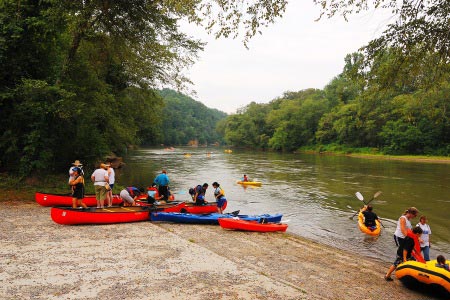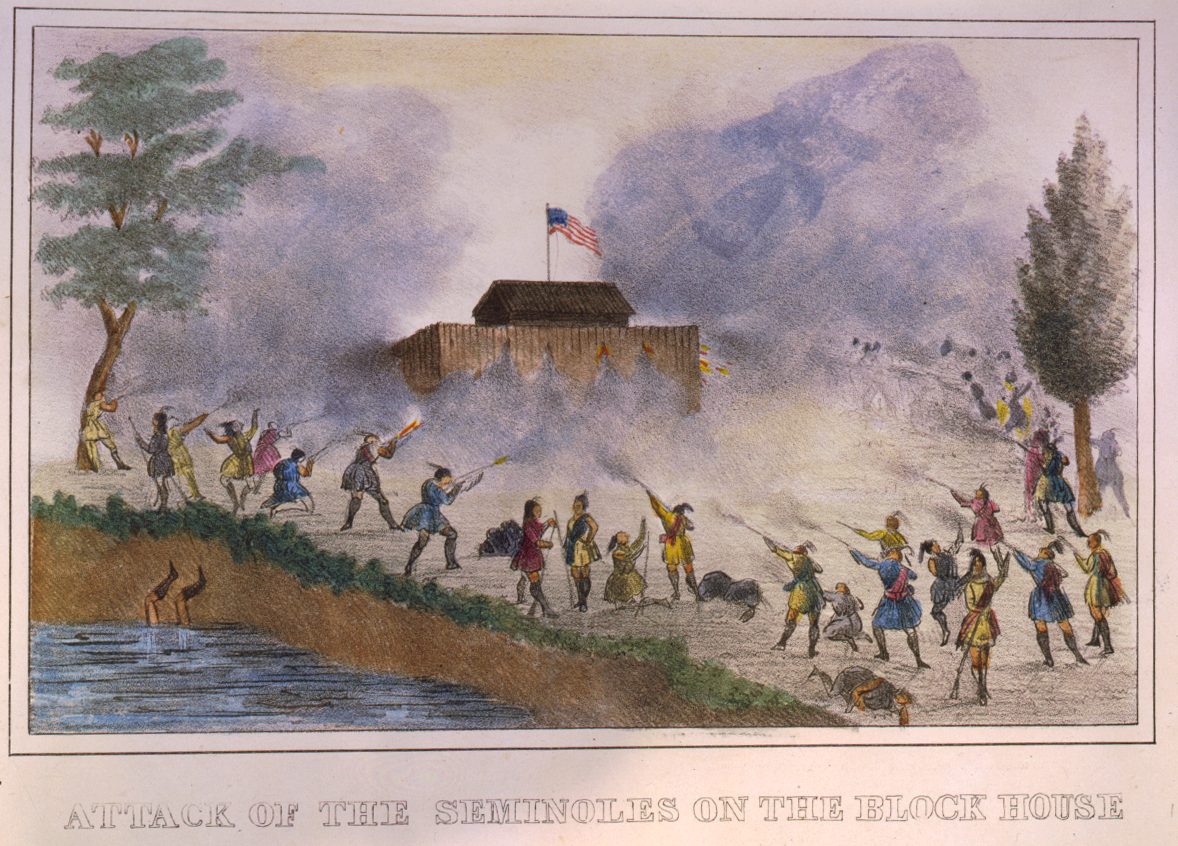|
Edmund Meredith Shackelford
Edmund Meredith Shackelford (September 26, 1786 – March 1, 1857) was an American brigadier general. Early life Shackelford was born in Hancock County, Georgia, on September 26, 1786. He was one of ten children of John Shackelford (1736–1800), a soldier in the American Revolutionary War, and Frances Wade Butler (1736-unknown). He was a member of the large Roger Shackelford family that immigrated to Virginia before 1678. Edmund Shackelford married Rebecca Power Brodnax in 1814. The Shackelfords and Brodnaxes were pioneers of Georgia and Alabama. The couple had four children. Shackelford's home in Autauga County, Alabama, is now known as the community of Kingston, Alabama. Career Edmund Shackelford was a 2nd lieutenant in the War of 1812. He served in the Georgia militia from August 23, 1812, through March 6, 1814. He served in Captain William E. Adams' Company of Riflemen in Major William Alexander's Rifle Battalion. On September 19, 1813, he was promoted to Brigade Inspe ... [...More Info...] [...Related Items...] OR: [Wikipedia] [Google] [Baidu] |
Hancock County, Georgia
Hancock County is a county located in the East Central part of the U.S. state of Georgia. As of the 2020 census, the population was 8,735. The county seat is Sparta. The county was created on December 17, 1793, and named for John Hancock, a Founding Father of the American Revolution. History Before the Civil War, Hancock County was developed for cotton plantations, as international demand was high for the commodity. The land was developed and the cotton cultivated and processed by thousands of enslaved African Americans. This area is classified as part of the Black Belt of the United States, primarily due to its fertile soil. It was later also associated with the slave society. Enslaved persons made up 61% of the total county population in the 1850 Census. Unusually for such a plantation-dominated society, the county's representatives at the Georgia Secession Convention, who were overwhelmingly white and Democratic, voted against secession in 1861. But the secession conven ... [...More Info...] [...Related Items...] OR: [Wikipedia] [Google] [Baidu] |
Chattahoochee River
The Chattahoochee River () is a river in the Southeastern United States, Southeastern United States. It forms the southern half of the Alabama and Georgia (U.S. state), Georgia border, as well as a portion of the Florida and Georgia border. It is a tributary of the Apalachicola River, a relatively short river formed by the confluence of the Chattahoochee and Flint River (Georgia), Flint rivers and emptying from Florida into Apalachicola Bay in the Gulf of Mexico. The Chattahoochee River is about long. The Chattahoochee, Flint, and Apalachicola rivers together make up the Apalachicola–Chattahoochee–Flint River Basin (ACF River Basin). The Chattahoochee makes up the largest part of the ACF's drainage basin. Course The River source, source of the Chattahoochee River is located in Jacks Gap at the southeastern foot of Jacks Knob, in the very southeastern corner of Union County, Georgia, Union County, in the southern Blue Ridge Mountains, a subrange of the Appalachian Mountai ... [...More Info...] [...Related Items...] OR: [Wikipedia] [Google] [Baidu] |
American Militiamen In The War Of 1812
American(s) may refer to: * American, something of, from, or related to the United States of America, commonly known as the "United States" or "America" ** Americans, citizens and nationals of the United States of America ** American ancestry, people who self-identify their ancestry as "American" ** American English, the set of varieties of the English language native to the United States ** Native Americans in the United States, indigenous peoples of the United States * American, something of, from, or related to the Americas, also known as "America" ** Indigenous peoples of the Americas * American (word), for analysis and history of the meanings in various contexts Organizations * American Airlines, U.S.-based airline headquartered in Fort Worth, Texas * American Athletic Conference, an American college athletic conference * American Recordings (record label), a record label that was previously known as Def American * American University, in Washington, D.C. Sports teams S ... [...More Info...] [...Related Items...] OR: [Wikipedia] [Google] [Baidu] |
1786 Births
Events January–March * January 3 – The third Treaty of Hopewell is signed between the United States and the Choctaw. * January 6 – The outward bound East Indiaman '' Halsewell'' is wrecked on the south coast of England in a storm, with only 74 of more than 240 on board surviving. * February 2 – In a speech before The Asiatic Society in Calcutta, Sir William Jones notes the formal resemblances between Latin, Greek, and Sanskrit, laying the foundation for comparative linguistics and Indo-European studies. * March 1 – The Ohio Company of Associates is organized by five businessmen at a meeting at the Bunch-of-Grapes Tavern in Boston to purchase land from the United States government to form settlements in the modern-day U.S. state of Ohio. * March 13 – Construction begins in Dublin on the Four Courts Building, with the first stone laid down by the United Kingdom's Viceroy for Ireland, the Duke of Rutland. April–June * April ... [...More Info...] [...Related Items...] OR: [Wikipedia] [Google] [Baidu] |
1857 Deaths
Events January–March * January 1 – The biggest Estonian newspaper, '' Postimees'', is established by Johann Voldemar Jannsen. * January 7 – The partly French-owned London General Omnibus Company begins operating. * January 9 – The 7.9 Fort Tejon earthquake shakes Central and Southern California, with a maximum Mercalli intensity of IX (''Violent''). * January 24 – The University of Calcutta is established in Calcutta, as the first multidisciplinary modern university in South Asia. The University of Bombay is also established in Bombay, British India, this year. * February 3 – The National Deaf Mute College (later renamed Gallaudet University) is established in Washington, D.C., becoming the first school for the advanced education of the deaf. * February 5 – The Federal Constitution of the United Mexican States is promulgated. * March – The Austrian garrison leaves Bucharest. * March 3 ** France and the United Kingdom f ... [...More Info...] [...Related Items...] OR: [Wikipedia] [Google] [Baidu] |
2nd Seminole War
The Second Seminole War, also known as the Florida War, was a conflict from 1835 to 1842 in Florida between the United States and groups of people collectively known as Seminoles, consisting of Creek and Black Seminoles as well as other allied tribes (see below). It was part of a series of conflicts called the Seminole Wars. The Second Seminole War, often referred to as ''the'' Seminole War, is regarded as "the longest and most costly of the Indian conflicts of the United States". After the Treaty of Payne's Landing in 1832 that called for the Seminoles' removal from Florida, tensions rose until fierce hostilities occurred in Dade's massacre in 1835. This engagement officially started the war although there were a series of incidents leading up to the Dade battle. The Seminoles and the U.S. forces engaged in mostly small engagements for more than six years. By 1842, only a few hundred native peoples remained in Florida. Although no peace treaty was ever signed, the war was de ... [...More Info...] [...Related Items...] OR: [Wikipedia] [Google] [Baidu] |
Thomas Jesup
Thomas Sidney Jesup (December 16, 1788 – June 10, 1860) was a United States Army officer known as the "Father of the Modern Quartermaster Corps". His 52-year (1808–1860) military career was one of the longest in the history of the United States Army. Biography Thomas Jesup was born in Berkeley County, Virginia (now West Virginia). He began his military career in 1808, and served in the War of 1812, seeing action in the battles of Chippewa and Lundy's Lane in 1814, where he was wounded. He was appointed Quartermaster General on May 8, 1818, by President James Monroe.Brigadier General Jesup, father of the Quartermaster Corps , US Quartermaster Foundation Seminole War and controversy In 1836, while Jesup was still officially Quartermaster General, President |
Winfield Scott
Winfield Scott (June 13, 1786May 29, 1866) was an American military commander and political candidate. He served as Commanding General of the United States Army from 1841 to 1861, and was a veteran of the War of 1812, American Indian Wars, Mexican–American War, and the early stages of the American Civil War. Scott was the Whig Party's presidential nominee in the 1852 election but was defeated by Democrat Franklin Pierce. He was known as Old Fuss and Feathers for his insistence on proper military etiquette and the Grand Old Man of the Army for his many years of service. Scott was born near Petersburg, Virginia, in 1786. After training as a lawyer and brief militia service, he joined the army in 1808 as a captain of the light artillery. In the War of 1812, Scott served on the Canadian front, taking part in the Battle of Queenston Heights and the Battle of Fort George, and was promoted to brigadier general in early 1814. He served with distinction in the Battle of Chippawa bu ... [...More Info...] [...Related Items...] OR: [Wikipedia] [Google] [Baidu] |
Battle Of Pensacola (1814)
The Battle of Pensacola (7–9 November 1814) took place, following the Creek War, as part of the Gulf Coast operations during the War of 1812. General Andrew Jackson led his infantry against British and Spanish forces controlling the city of Pensacola in Spanish Florida. The Spanish forces surrendered the city to Jackson, and the outlying British contingent withdrew. The battle was the only engagement of the war to take place in territory under the sovereignty of the Kingdom of Spain. Background Horseshoe Bend Many refugees fled to Spanish West Florida (see Prospect Bluff) after the Red Stick Creeks were defeated at the Battle of Horseshoe Bend at the end of the Creek War. Captain Woodbine of the Royal Marines made contact with Indians. After a meeting of various elders held aboard HMS Orpheus (1809) on May 20, weapons and other gifts were provided by the British. Woodbine was appointed as British Agent to the Creek Nations. The presence of the Orpheus in the Apalachicol ... [...More Info...] [...Related Items...] OR: [Wikipedia] [Google] [Baidu] |
American Revolutionary War
The American Revolutionary War (April 19, 1775 – September 3, 1783), also known as the Revolutionary War or American War of Independence, was the armed conflict that comprised the final eight years of the broader American Revolution, in which American Patriot (American Revolution), Patriot forces organized as the Continental Army and commanded by George Washington defeated the British Army during the American Revolutionary War, British Army. The conflict was fought in North America, the Caribbean, and the Atlantic Ocean. The war's outcome seemed uncertain for most of the war. However, Washington and the Continental Army's decisive victory in the Siege of Yorktown in 1781 led King George III and the Kingdom of Great Britain to negotiate an end to the war in the Treaty of Paris (1783), Treaty of Paris two years later, in 1783, in which the British monarchy acknowledged the independence of the Thirteen Colonies, leading to the establishment of the United States as an independent and ... [...More Info...] [...Related Items...] OR: [Wikipedia] [Google] [Baidu] |
Battle Of Horseshoe Bend (1814)
The Battle of Horseshoe Bend (also known as ''Tohopeka'', ''Cholocco Litabixbee'', or ''The Horseshoe''), was fought during the War of 1812 in the Mississippi Territory, now central Alabama. On March 27, 1814, United States forces and Native Americans in the United States, Indian allies under Major General Andrew Jackson defeated the Red Sticks, a part of the Creek people, Creek Indian tribe who opposed American expansion, effectively ending the Creek War. Background The Creek people, Creek Indians of Georgia (U.S. state), Georgia and the eastern part of the Mississippi Territory had become divided into two factions: the Upper Creek (or Red Sticks), a majority who opposed American expansion and sided with the United Kingdom of Great Britain and Ireland, British and the colonial authorities of Spanish Florida during the War of 1812; and the Lower Creek, who were more assimilated into the Anglo-Americans, Anglo culture, had a stronger relationship with the U.S. Indian Agent Benj ... [...More Info...] [...Related Items...] OR: [Wikipedia] [Google] [Baidu] |






